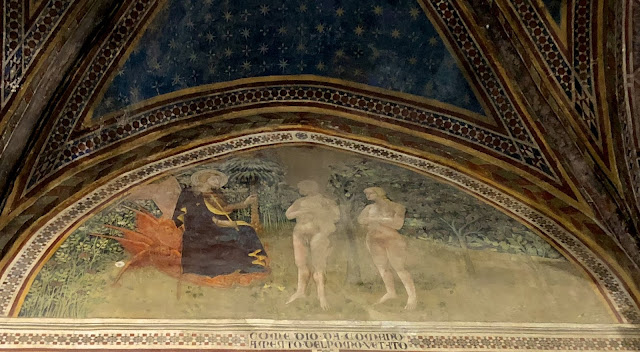I took a stroll down the dirt road to collect flowers for our room - blue cornflowers, purple clover and a variety of other flowers in yellow purple and white. I admired the aged farm equipment (this contraption is used to collect and bail hay) and its juxtaposition with the ever present vines.
Returning to the Agriturismo Paradiso, I got my first chance to see it in the daylight. Here's the driveway that gave me so much trouble the night before.
The farmhouse and the grounds were lovely.
After a leisurely breakfast at the agriturismo, we headed north through the countryside to San Gimignano - almost all the way back to Volterra.
The Tuscan landscapes stretched out as far as the eye could see. As Rick Steves puts it "Rolling hills topped with medieval towns, olive groves, rustic stone farm houses and a skyline punctuated with cypress trees. Fields painted yellow and green with fava beans and broom, dotted with red poppies and sunflowers...
...where clay outcroppings would pop up from time to time and add to the varied landscapes.
As we approached from the south, San Gimignano and its towers rose out of the fields to assume a commanding presence on its hilltop.
San Gimignano has been called the epitome of a Tuscan hill town. Unfortunately, only 14 of the original 72 towers remain. Before city walls were constructed, towers were built to protect to wealthy families during periods of war between the city states.
After parking the car at Parcheggio Montemaggio, we started our exploration of the city at the Porta San Giocanni, passing under the walls built in the 13th century.
Once inside, you could get a sense of how the 13,000 people used to live within the city walls. In the 14th century, a six-month plague decimated the population and left only 4,000 survivors. Once fiercely independent, San Gimignano came under the control of Florence and was forced to tear down most of its towers. Florence also directed trade away from San Gimignano and the town never recovered. Ironically, the town's poverty left the architecture in a time warp and that has led to its prosperity as a tourist destination today.
Walking up the Via San Giovanni towards the civic center of the town...
...past interesting side street enclaves
where I fell in love with the artwork of Aldo Ezio Cornelie....
...and continuing on the Via San Matteo, past more towers and through the Arco dei Becci...
to the Piazza della Cisterna with its (tower) Torre del Diavolo...
and vine covered residences.
Window detail....

From this angle in the Piazza del Duomo, one of the "twin towers" blocks the sight of the other.
In the photo below, the tower on the left is the Merchants Tower which once held a ground-floor shop, warehouse upstairs, living quarters, and the kitchen on top (for fire safety reasons). The holes in the walls supported wooden balconies and exterior staircases. The tower was built with heavy stone for support at its base with lighter brick in the upper stories.
In the photo above, to the right of the Merchant's Tower, lies the City Hall and its 170 foot tower nicknamed the "bad news tower". The bells on this tower only rang for fires or wars.
After we toured the 360 degree main square, we entered the Duomo. Inside the Romanesque cathedral, Siense Gothic art lines the nave with parallel themes - Old Testament on the left and New Testament on the right.
Looking towards the rear of the cathedral...
The organ with its massive pipes...

Looking at all the Old Testament panels, I was reminded of something I heard or read - that most people that were around when these cathedrals were built were illiterate and so the paintings, while beautiful, had a distinct function. They were able to tell the story of the bible in picture format - an early form of the graphic novel.
The creation of the earth showing the world as it was known in biblical times.
God creates Adam....
God gives Adam dominion over the earth and its creatures...
As Adam sleeps, God creates Eve to be his companion...
God, settin' down the rules...
Noah, go build the arc...
Moses escaping by parting the seas ...
New Testament - the Annunciation....
A side chapel honoring the Virgin Mary...
Turning around to take in the main alter...
The St. Fina Chapel honors the 13th-century local girl who brought forth many miracles on her death. Michelangelo's teacher, Dominico Ghirlandaio, painted the ceiling frescoes that depict scenes from her life. The alter sits atop Fina's skeleton
After a tour of the Duomo, I couldn't resist climbing the new City hall's 200-foot tower, the Torre Crossa, for photos of San Gimignano's rooftops and the fields beyond.
On the way up the 218 steps...
A peek before the top...

Wow, what commanding views!
Below, looking north past the twin towers and the Casa-Torre Pesciolini...
Below, looking southwest into the countryside...

Below, looking east...

Below, looking west southwest...
Climbing back down from the tower, I stopped to admire one of the paintings from the Pinacoteca in the Civic Museum.
While I was up in the tower, KAthi captured this wedding at the Duomo.
Continuing along the Via San Matteo, we eventually arrived at the Porta San Matteo at the northwestern end of the city.
Not far from the city walls, the landscape quickly evolves into a patchwork of olive groves and farm fields.
Although there were some things we could have done and seen to get an even greater appreciation of San Gimignano, we wanted to go to Sienna to do some preliminary exploring and nail down some pre-Palio logistics. Please continue on to the next blog post.












































No comments:
Post a Comment